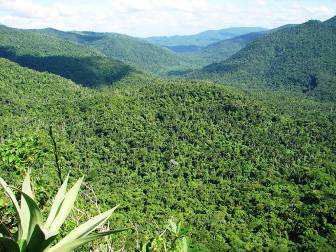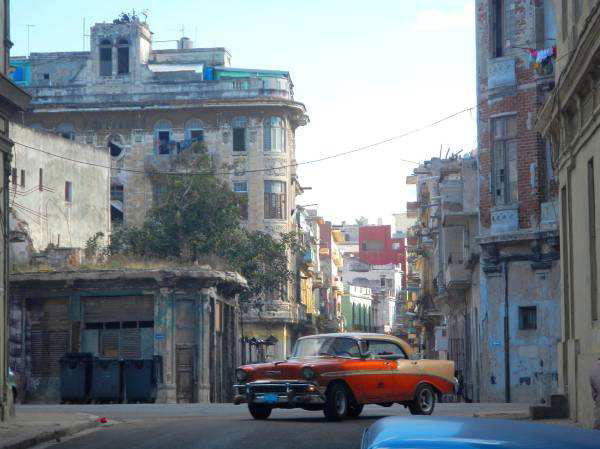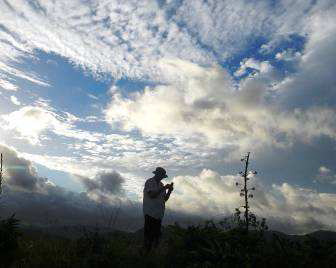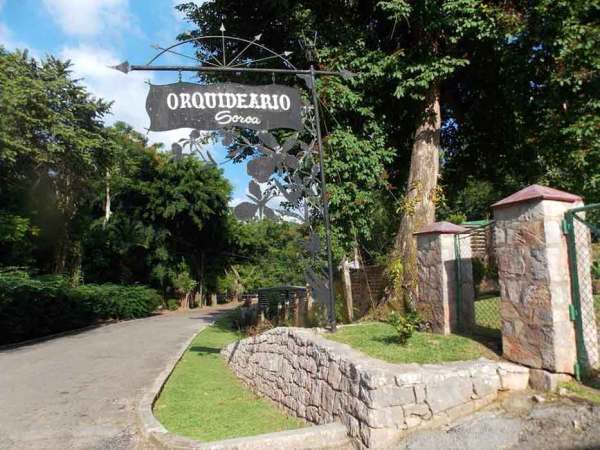Lost and Found in Cuba, Part 1
by Dennis Giardina

Sierra del Rosario Biosphere Reserve
I never thought I would be able to go to Cuba. In the past I’ve spent hours looking at maps of the Caribbean, and I’ve wondered about the region’s largest island, its environs, flora and fauna. Cuba is a biodiversity powerhouse. It’s the principal center of evolution and speciation in the Antilles (the major islands of the Caribbean) and one of the most biologically diverse islands in the world, with 42 distinct ecosystems and 23 landscape types.
There are 6,519 known vascular plants, including around 350 native orchid species and there are 16,516 documented animal species. Of Cuba’s 612 vertebrate species, 15 mammals, 91 reptiles, 43 amphibians, 23 fish and 22 birds are endemic. In fact approximately 50% of Cuban plants and 42% of Cuban animals can only be found there. Yes, I dreamed about going to Cuba but there were obstacles, seemingly insurmountable, preventing me from doing so.

Dennis was taking a picture down an Old Havana side street when this car turned onto it. Havana has many old American cars from the 1940s and 1950s.
It’s difficult to talk about Cuba without geopolitics creeping into the conversation. Everyone seems to have an opinion about the Republic of Cuba and its complicated historical relationship with the United States of America, as I suppose I also do. I think that most people would agree that regardless of our different customs, governments, religions and societal structures, human beings are more or less the same everywhere – part murderous monkey, part divine angel and every conceivable thing in between. Regardless, I am way more inspired by the natural world than by the political one. That is what attracted me to Cuba in the first place and is what I hope will eventually bring me back there.
Fakahatchee Park Biologist Mike Owen and I have been working together with Matt Richards of Atlanta Botanical Garden’s Orchid Conservation Center to experimentally restore colonies of the cigar orchid, Cyrtopodium punctatum to the Fakahatchee Strand. They were once numerous but are now extremely rare due to over-collecting in the 20th Century. In fact, when we began our project in 2007 there were less than 20 known cigar orchids within the entire Preserve.

Mike standing on a mountain peak against cloud formation associated with the passage of Hurricane Sandy.
Two other species of epiphytic orchid, Epidendrum acunae and Bulbophyllum pachyrachis, were wiped out by collectors during that same era. In the U.S. they were only known to occur naturally in the Central Slough of the Fakahatchee Strand. Even before the industrial logging period, they were probably rare, found in disjunctive populations composed of few individuals where deep water and the super canopy protected them from frost and desiccation. The nearest wild populations of Fakahatchee’s two “lost orchids,” Epidendrum acunae and Bulbophyllum pachyrachis naturally occur in Western Cuba, where coincidentally Mike, Matt and I were invited to attend an international orchid conference to present a paper on our cigar orchid restoration project.
The VIII International Orchid Workshop was held about 50 miles west of Havana at Soroa Botanical Garden. Soroa is located within the Sierra del Rosario Biosphere Reserve, on the eastern slopes of the Guaniguanico Mountain Range in Pinar de Rio Province. It spans about 66,000 acres, and its highest peaks reach about 2,000 feet above sea level from where one can view both the north and south coasts. Soroa Botanical Garden was built upon a karst hilltop where the limestone and vegetation seem to blend one into the other.
Rocky stairways wind up, down and around through collections of palms and trees, flowering plants of all sorts and orchids, lots of orchids. Soroa Botanical Garden has the greatest collection of native Cuban orchids in the country. We spent six days in Soroa but Mike and I hardly saw any of the botanical garden or the surrounding mountainside. Most of the time we were there, we were either in the stone building up in the garden where the workshop took place, eating in a restaurant or on a field trip.

A stairway within the Soroa Botanical Garden laden with orchids
The talks were presented in three languages (English, Portuguese and Spanish) with lots of pauses for translation across the cosmopolitan room. Mike and I gave our presentation in both English and Spanish. At the end of our slide show, I made a proposition to the Cuban botanists in attendance, but especially to Dr. Rolando Perez, the organizer of the Workshop and the Director of Science there at Soroa Botanical Garden.
Our last slide showed a satellite map of the Caribbean, with arrows pointing to Fakahatchee Strand and Soroa, Cuba, demonstrating how close the two are to one another. Both places and their respective land masses are separated only by the Straits of Florida. I said that Mike and I would like to attempt an experimental restoration of the two Fakahatchee lost orchids using seed from populations of both species from the Soroa area.
I told them that my dream was to locate plants already in cultivation in a private collection or a botanical garden in Cuba that were grown from local, wild seed. Step two would be to enlist someone to pollinate them, collect their seeds and send them to Soroa Botanical Garden. Somehow then we’d arrange a way to transfer those seeds from Soroa to our partner Atlanta Botancial Garden so they could grow the Epidendrum acunae and Bulbophyllum pachyrachis plants. After two years of growth in Atlanta, the plants could be ready to out-plant in Fakahatchee. Finally, we celebrate with our Cuban collaborators who will be with us in Fakahatchee when we establish our first experimental restoration plot of one of the lost orchid species.
As I laid down our proposal, I had an eye on Dr. Perez who sat very stoically in the front row. Some of the other Cuban botanists approached me at the break following our presentation and expressed their interest in our project but I didn’t get a chance to talk to Dr. Perez. The next day, at the end of the morning session, Dr. Perez asked me to sit down with him to talk more about the details of what I proposed.
Dr. Perez and I had been developing a rapport over the previous two days, and I was really hoping that he would be receptive to our invitation to collaborate with us, especially after we learned that he and his daughter Yunelis were leading a similar experimental orchid restoration project in the Sierra del Rosario Biosphere Reserve. After we talked a while, he said that he might be able to help us and we shook hands. He told me to come back from lunch a little early and to bring Mike with me.
I ran down to the little restaurant where Mike and the rest of the Workshop attendees were about to be served lunch. I grabbed Mike and I said, “Mike, Dr. Perez seems like he’s willing to work with us and he told me to get you and come back early because he wants to show us something.” We were both famished but there wasn’t time for me to order and eat so we split his lunch and hurried back up to the botanical garden. We found Dr. Perez who grabbed his keys and led us about a hundred fifty feet from the conference room where the Workshop was being held, to a locked shade house. He opened the door and we walked through …
Dennis Giardina is the Everglades Region Biologist for the Florida Fish and Wildlife Conservation Commission and was formerly the Park Manager of Fakahatchee Strand Preserve.

